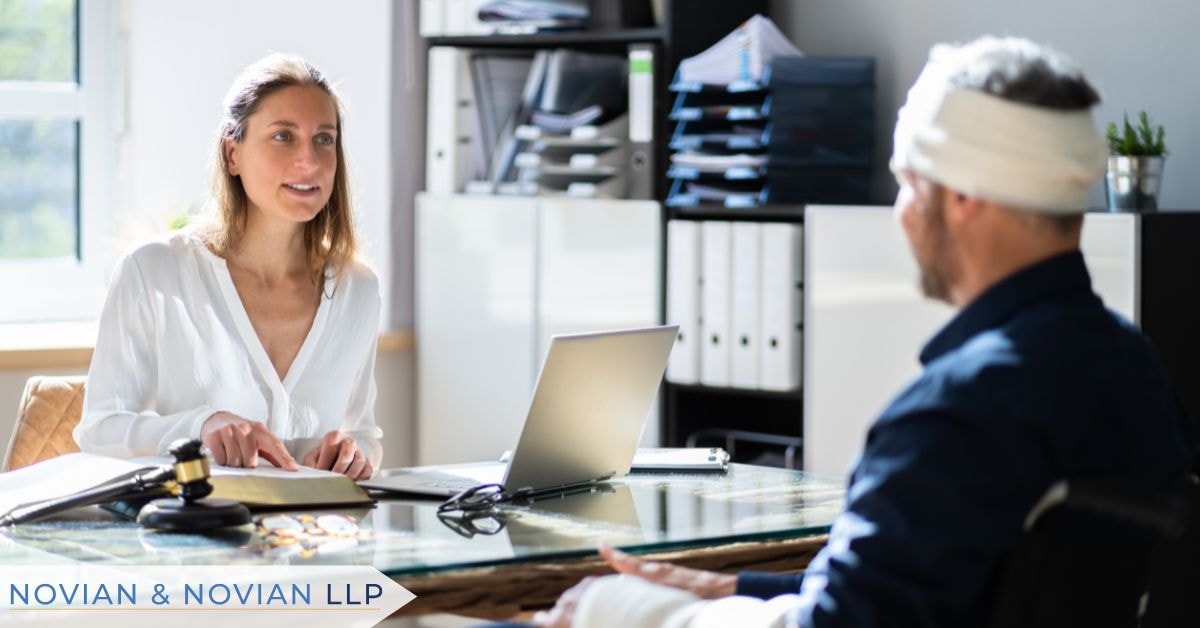
A typical personal injury settlement provides compensation for individuals who have suffered harm due to someone else’s negligence. The aim of these settlements is for the victims to be able to pay for damages incurred due to the injury, such as medical bills, loss of income, pain and suffering, etc. To ensure you are getting adequate compensation for your injuries, you have to know the average personal injury settlement amount.
While there is no fixed amount for every case, the average personal injury settlement ranges from a few thousand dollars to well over $75,000, depending on the unique details of the claim.
At Novian & Novian, our team of expert personal injury lawyers have years of experience guiding individuals through the complex legal process of personal injury cases and will strive to get you the best compensation possible. Contact us today for a free consultation.
In this guide, you will learn more about personal injury settlements and the elements that determine the exact amount you will get. We will also discuss what you should do if you get a low settlement offer.
What Is the Average Personal Injury Settlement Amount?
On average, personal injury settlements range between $10,000 and over $75,000. A settlement is a financial agreement reached between the injured party and the party at fault or their insurance company to compensate for damages caused by an accident or negligence. These damages often include medical bills, lost wages, pain and suffering, and other expenses related to the injury.
Personal Injury Cases Settlement Amounts
While personal injury settlement amounts vary significantly based on the facts of each case, certain trends emerge across the most common types of claims. Factors such as the severity of injuries, impact on the injury victim’s daily life, and the expertise of an experienced personal injury attorney can all influence the final payout.
Some common types of personal injury claims include:
- Car Accidents: Car accident settlements typically range from $15,000 to $50,000, depending on factors such as the severity of the injuries, the extent of property damage, and the available insurance coverage. Car accident victims with severe injuries often receive higher settlements.
- Slip and Fall Accidents: The average payout for slip-and-fall injuries can range from $10,000 to $50,000, but cases involving severe injuries can exceed $100,000.
- Medical Malpractice Cases: Medical malpractice settlements tend to be higher than those in other personal injury cases, often exceeding $250,000, due to the complexities involved and the significant impact of medical negligence on the injured party’s life.
- Product Liability: Cases involving defective products can result in settlements ranging from $50,000 to $300,000, with higher payouts if the injury causes long-term disability or severe harm.
- Spinal Cord Injuries: Spinal cord injuries are among the most devastating and costly, frequently resulting in settlements over $500,000. These injuries can lead to permanent paralysis, requiring lifelong medical care, adaptive equipment, and modifications to the injury victim’s daily life.
- Wrongful Death: In wrongful death cases, surviving family members may receive settlements ranging from $500,000 to several million dollars, depending on factors like the deceased’s income, age, and the emotional and financial losses endured. These cases often account for loss of earning capacity, loss of companionship, and funeral expenses.
- Loss of Earning Capacity: When an injury impacts the victim’s ability to work or pursue their career, compensation for loss of earning capacity is calculated based on projected future income. This can lead to settlements in the high six-figure to multi-million-dollar range, particularly when the victim is young or held a high-earning profession before the injury.
Personal injury cases involving catastrophic injuries, such as traumatic brain injuries, spinal cord damage, or severe burns, often result in the highest payouts. These injuries require extensive medical treatment, ongoing care, and significant lifestyle changes, leading to settlements that can exceed $1 million. Cases involving gross negligence or intentional harm can also yield higher settlement amounts.
| Type of Case | Average Settlement |
|---|---|
| Car Accidents | $15,000 – $50,000 |
| Slip and Fall Accidents | $10,000 – $50,000+ |
| Medical Malpractice | $250,000+ |
| Product Liability | $50,000 – $300,000 |
| Dog Bites | $30,000 – $50,000 |
| Workplace Injuries | $20,000 – $80,000 |
| Wrongful Death | $500,000 – $1,000,000+ |
| Traumatic Brain Injury | $100,000 – $500,000+ |
| Spinal Cord Injuries | $10,000 – $500,000+ |
Outliers: Extremely High or Low Settlements
While the average personal injury settlement ranges from a few thousand dollars to several hundred thousand, there are exceptions. For example, low settlement cases that involve minor injuries and damages often settle for smaller amounts, sometimes under $10,000. These settlements cover basic medical expenses and lost wages but may not involve compensation for pain and suffering.
On the other end of the spectrum, high settlement cases involving catastrophic injuries or gross negligence can result in multi-million dollar settlements. These cases often involve significant medical bills, long-term disability, and a profound impact on the victim’s quality of life.
The national average settlement for personal injury cases can vary widely depending on the nature of the case. For example, average settlements for car accidents or slip-and-fall injuries can fall between $15,000 and $30,000, while medical malpractice cases often average significantly higher due to the complexity and severity of injuries involved. Typically, personal injury settlements can also differ considerably by state or region due to various factors such as cost of living, jury verdict trends, and state laws. This is why consulting with local personal injury attorneys who understand the nuances of your area is important for obtaining a fair settlement.
Key Elements That Determine Personal Injury Settlement Amount
When seeking compensation in a personal injury claim, several critical factors determine the settlement amount. One of these factors is the severity of the injuries. The more severe the injury, the higher the potential settlement. Injuries like traumatic brain injuries (TBI), spinal cord injuries, or severe burns often result in larger settlements because of the significant physical, emotional, and financial impact on the victim. These injuries usually require extensive medical treatment, rehabilitation, and long-term care, making them costly for both the injured party and the at-fault party.
Another factor that determines the amount is medical expenses. This includes current medical bills like hospital visits, surgeries, medications, and rehabilitation. This is particularly important for injuries that require ongoing treatment or care, such as spinal cord injuries or chronic pain conditions. The higher the medical costs, the larger the settlement is likely to be, as compensation is designed to cover both past and future expenses. In cases involving long-term injuries, future medical costs are also factored into the settlement.
In addition to medical costs, lost income and earning capacity play a role in calculating settlements. If the injury has forced you to miss work, your lost wages will be included in the compensation. Furthermore, if the injury affects your ability to work in the future, reducing your earning capacity, this too, will increase the settlement amount. For example, if you suffer a permanent injury that prevents you from returning to your previous job or reduces your ability to work full-time, the settlement will account for future lost income as well.
Pain and suffering damages also determine the amount that will be paid. They compensate for the emotional distress, mental anguish, and diminished quality of life caused by the injury. If you suffer from conditions like PTSD, chronic pain, or depression due to the accident, these non-economic damages can significantly raise the settlement amount. Unlike medical expenses or lost wages, pain and suffering damages are subjective and more difficult to calculate.
Examples of pain and suffering settlements include a car accident victim experiencing chronic back pain and PTSD who could receive an additional $50,000 to $200,000 in pain and suffering compensation. Another example is that of a burn victim facing permanent disfigurement and emotional trauma who may receive well over $500,000 in non-economic damages alone.
Furthermore, the degree of liability and fault play a role in determining settlement amounts. In cases where comparative negligence applies, the settlement could be reduced based on the injured party’s percentage of fault. For example, in California, if you are found to be 20% at fault for the accident, your settlement might be reduced by 20%. In cases where liability is clear and the other party is entirely at fault, the settlement will likely be higher. These negligence settlement amounts depend heavily on how fault is distributed and how effectively your attorney can argue your case.
Another factor that affects the settlement amount is the insurance company, as the at-fault party’s insurance policy limits can cap the amount you receive in a settlement. Even if your injuries are severe and your medical expenses are substantial, if the at-fault party’s insurance coverage is limited, your settlement might not cover all your damages. However, having an experienced attorney can help you explore additional avenues for compensation, such as underinsured motorist coverage or the personal assets of the at-fault party.
It is important to remember that while most personal injury cases settle before going to trial, you can still take your case to court if you feel your settlement amount is inadequate.
If your case goes to trial, the final settlement amount could increase due to the uncertainty and potential for a more significant jury award. On the other hand, if you settle outside of court, you might receive a slightly lower amount in exchange for avoiding the time, stress, and uncertainty of a trial.
Common Mistakes That Can Lower Your Settlement
One of the biggest mistakes you can make is delaying or avoiding medical treatment after an accident. Insurance companies will use this as evidence that your injuries aren’t serious or that they were not caused by the accident. It is best to seek immediate medical care and follow through with all recommended treatments to ensure your injuries are properly documented. Failing to do so can significantly reduce your personal injury settlement.
After an accident, many victims feel pressured to accept the first settlement offer from the insurance company. However, this initial offer is often much lower than the actual value of your claim. Settling too quickly can result in inadequate compensation, especially if the full extent of your injuries or future medical expenses is not yet clear. It is always best to wait until you have a comprehensive understanding of your injuries and damages. This ensures that you receive a fair settlement.
Furthermore, you should not go through a personal injury claim without consulting an experienced personal injury attorney. Attorneys understand how to calculate pain and suffering damages, gather crucial evidence, and effectively negotiate with insurance companies to maximize your settlement amount. Without expert legal guidance, you are more likely to accept a lowball offer or make critical mistakes in your case.
The Role of a Skilled Personal Injury Attorney
A good attorney thoroughly evaluates your case. They ensure that all aspects of your injuries, including severe injuries, medical bills, lost wages, and pain and suffering, are accounted for when calculating the settlement.
Another role of a skilled personal injury attorney is evidence collection and presentation. Attorneys gather and present the necessary evidence to support your case. This evidence includes medical records, accident reports, and witness statements. They increase your chances of securing a higher personal injury settlement amount.
Furthermore, these attorneys bring expert knowledge of laws and regulations. Their deep understanding of state laws and personal injury regulations helps you navigate the complex legal process and avoid pitfalls that could jeopardize your claim.
Additionally, a personal injury lawyer has effective negotiation skills. They negotiate with insurance companies and opposing legal terms on your behalf. This ensures you receive fair compensation for both economic and non-economic damages.
At Novian & Novian, our experienced attorneys are committed to securing the best possible settlement for you. With a proven track record of successful personal injury settlements, we provide expert legal guidance and advocacy every step of the way.
What to Do if You Receive a Low Settlement Offer?
When dealing with a personal injury case, receiving a low settlement offer from an insurance company can be frustrating. A good settlement compensates you fairly for all your damages, including medical bills, lost wages, pain and suffering, and future medical expenses. A reasonable settlement covers both economic and non-economic damages and reflects the extent of your injuries.
If your injuries are minor, you might receive a few thousand dollars, but more severe injuries like spinal cord injuries or traumatic brain injuries can lead to settlements in the six-figure range.
Here is what to do if you receive a low settlement offer:
Evaluate the Offer
When evaluating a settlement offer, you should assess medical expenses and ensure it includes hospital bills, physical therapy, prescription medication, and any other necessary care. If your injuries caused you to miss work or reduced your ability to earn in the future, the settlement should account for these lost earnings and future earning capacity.
Furthermore, a good settlement offer should factor in pain and suffering, such as emotional distress and pain and suffering damages. Typically, a personal injury attorney can help quantify these damages based on legal precedents and the severity of your injuries.
If your accident resulted in property damage, such as a damaged vehicle in a car accident, these costs should also be included in the settlement. Consulting with an experienced attorney will give you an expert opinion on whether the offer meets the standard for a fair personal injury settlement.
Steps to Negotiate a Higher Settlement
The first step to negotiating a higher settlement is consulting with a personal injury lawyer. An attorney will assess the offer and guide you on how to counter the insurance company. Typically, most personal injury lawyers have the experience to calculate a fair settlement amount and help maximize your compensation.
To support your demand for a higher settlement, provide thorough documentation, including medical records, expert opinions, and evidence of lost wages or other costs. The more comprehensive your evidence, the stronger your case for a higher settlement.
Once you have all the documentation, you should submit a counteroffer backed by your attorney’s guidance and solid evidence. Insurance companies are more likely to negotiate if they see you have strong legal representation and compelling evidence.
In some cases, negotiations may not lead to a satisfactory resolution. Therefore, you need to prepare for possible litigation. However, having an attorney who is ready to file a personal injury lawsuit can increase the pressure on the insurance company to offer a fair settlement.
Can You Reopen a Case After Accepting a Settlement?
Once you accept a settlement offer and sign a settlement agreement, you cannot reopen the case or claim additional compensation, even if your injuries worsen later. This is why it’s essential to consult with a personal injury attorney before accepting any offer.
Your attorney will ensure the settlement accounts for future medical costs and other potential long-term damages. If the settlement does not reflect these factors, they will help negotiate a better deal.
When and How Do You Receive a Personal Injury Settlement?
Once you have negotiated and agreed on a settlement amount, the next step is to await payment. Below is an overview of expectations to have when it comes to receiving a personal injury settlement.
How Are Personal Injury Settlements Paid?
Once you reach a settlement agreement in a personal injury case, there are generally two main methods of payment: lump-sum payments and structured settlements. Lump-sum payments are the most common method of payment in personal injury settlements. In this case, the injured party receives the entire agreed-upon settlement amount at once. This is beneficial if you have immediate financial needs such as medical bills, property damage, or lost wages. Many choose lump-sum payments to cover all current and future medical costs without waiting for incremental payments.
However, in larger settlements or cases where the injured party may have ongoing medical needs, a structured settlement may be offered. This type of payment distributes the settlement over time, with periodic payments (monthly, annually, etc.). Structured settlements are often used when the settlement amount is substantial or when the injured party may require ongoing care, such as in cases involving severe injuries like spinal cord injuries or traumatic brain injuries.
Structured settlements provide long-term financial security and are often customized to ensure that the injured party is financially covered for years to come. These arrangements may also help avoid certain tax implications.
When Are Settlements Paid?
The average personal injury settlement payout typically occurs within weeks to a few months after the settlement is agreed upon. However, this timeframe can be affected by several factors, including the complexity of the case, the size of the settlement, and the processing time required by the insurance company or court system.
Payouts may occur sooner in more straightforward cases with clear liability and no significant disputes. On the other hand, cases involving severe injuries, substantial medical expenses, or disputes over the settlement amount may take longer to finalize.
In some cases, payouts can be expedited. For example, when liability is not disputed and the case involves minor injuries, settlements may be fast-tracked. Additionally, if there are no liens or outstanding legal or medical claims on the settlement, the payout process is generally faster.
In situations where you need immediate financial assistance, pre-settlement funding options may be available. These allow you to access a portion of your expected settlement before the final payout. However, it is important to consult with your personal injury attorney before agreeing to such terms, as they can impact your overall compensation.
Ready to Maximize Your Settlement Amount?
This blog has covered the steps and strategies to ensure you get the best possible outcome for your personal injury settlement. Common mistakes that can lower your settlement include things like delaying medical treatment or settling too quickly.
On average, a personal injury settlement ranges between $10,000 and over $75,000. However, navigating personal injury claims can be complex, especially when dealing with insurance companies. Therefore, it is important to seek professional legal advice to avoid costly mistakes and maximize your settlement amount.
If you’ve been injured and are ready to pursue a personal injury claim, our expert team of personal injury attorneys in Los Angeles at Novian & Novian is here to help. With their comprehensive legal knowledge and experience in personal injury cases, they will work to ensure you receive the compensation you deserve. Schedule a free consultation today!
Contact Us
Have questions about this post? Novian & Novian is a full service law firm in Los Angeles with clients that span the country. Contact us today for a free consultation.
Contact Us
Have questions about this post? Novian & Novian is a full service law firm in Los Angeles with clients that span the country. Contact us today for a free consultation.




